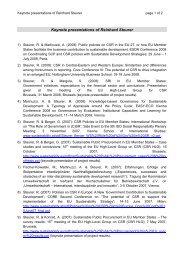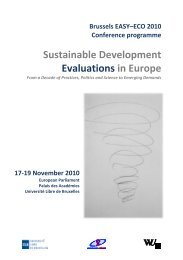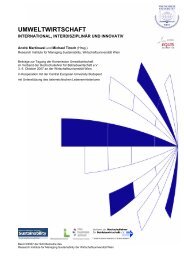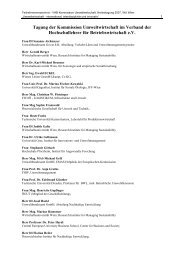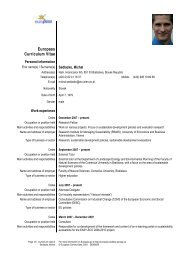Scope of research - Institute for Managing Sustainability
Scope of research - Institute for Managing Sustainability
Scope of research - Institute for Managing Sustainability
You also want an ePaper? Increase the reach of your titles
YUMPU automatically turns print PDFs into web optimized ePapers that Google loves.
EASY-ECO EvAluation <strong>of</strong> SustainabilitY EuroCOnferences<br />
GuidelineB_scope<br />
GUIDELINE PART B<br />
Definition <strong>of</strong> the scope <strong>of</strong> <strong>research</strong><br />
to be used in Phase 2<br />
Some evaluations do not have the word “evaluation” in their title, some reports called<br />
“evaluations” are no “real” evaluations. The following checklist wants to support you (the<br />
young <strong>research</strong>ers) when making the decision which evaluation reports to analyse in detail<br />
and which not. Thus comparable analyses (between the countries) shall be ensured. The<br />
checklist below lists the criteria an evaluation report has to have, in order to be considered a<br />
report <strong>of</strong> an “evaluation <strong>of</strong> sustainable development”. The checklist also contains<br />
explanations and examples.<br />
If the application <strong>of</strong> the criteria <strong>of</strong> the checklist is extremely reducing the number <strong>of</strong> available<br />
reports – please contact the EASY-ECO Team!<br />
One or two criteria might have to be changed then, but please agree with us on such an<br />
adaptation first!<br />
An evaluation report should fulfil all <strong>of</strong> the following criteria:<br />
1. Applied science carrying out a systematic analysis page 2<br />
2. <strong>of</strong> the causal effects and relationships <strong>of</strong> an intervention page 3<br />
3. including a judgement page 4<br />
4. based on the integrated treatment <strong>of</strong> all the three<br />
dimensions <strong>of</strong> sustainable development<br />
page 5 + annex<br />
5. in a transparent process page 5<br />
One the following pages it is explained by means <strong>of</strong> a case study (creation <strong>of</strong> a national park)<br />
how to use the checklist. In case <strong>of</strong> any questions or doubts while interpreting and using the<br />
checklist, please use the <strong>for</strong>um at www.sustainability.at/easy - we will answer your questions<br />
there.<br />
Supported by the European Commission, Research DG, Human Potential Programme 1/11<br />
High-Level Scientific Conferences, Contract No. HPCF-CT-2001-00286
EASY-ECO EvAluation <strong>of</strong> SustainabilitY EuroCOnferences<br />
GuidelineB_scope<br />
1. Applied science carrying out a systematic analysis<br />
Evaluation is applied science and should be based on sound methods and theories. It is not<br />
necessary that these theories are documented explicitly in the evaluation report, but they<br />
should be the basis <strong>for</strong> the evaluation project. Methods <strong>of</strong> data-collection, analysis and<br />
interpretation should be suitable to the evaluandum and should reflect the state <strong>of</strong> the art.<br />
Case: National Park<br />
A1 A journalist writes an article on the opinions <strong>of</strong> people living in the national park<br />
region, emphasising on their different needs and requirements.<br />
Conclusio: This is NO evaluation, because it is not applied science but journalism (an<br />
individual statement <strong>of</strong> a single person is accepted in journalism, but it is not sufficient in<br />
science) .<br />
A2 A expert on tourism writes a report about the development he expects <strong>for</strong> the region.<br />
He does refer to general trends in tourism but the paper focuses on his personal opinion.<br />
Conclusio: This is NO evaluation, because it is not a systematic analysis.<br />
A3<br />
A monitoring system <strong>for</strong> groundwater flows is being implemented.<br />
Conclusio: The monitoring system can provide the data <strong>for</strong> an evaluation, but it is NO<br />
evaluation itself.<br />
A4. In order to measure the effects <strong>of</strong> the national park, a mathematical model (e.g. Multi-<br />
Criteria-Analysis), is being developed and explained in a study.<br />
Conclusio: It is fundamental <strong>research</strong> but not applied science – there<strong>for</strong>e it is NOT considered<br />
an evaluation. Only when the model is used in a case study, it becomes part <strong>of</strong> an evaluation.<br />
A5 A regional planning document prioritises several environmental measurements,<br />
ranking the national park first.<br />
Conclusio: This document ranks measurements but does not say anything about the<br />
anticipated effects <strong>of</strong> the national park – it is there<strong>for</strong>e NO evaluation..<br />
A6 A systematic and representative study carries out an opinion poll including the<br />
important stakeholders <strong>of</strong> the national park and derives the anticipated landuse conflicts.<br />
Conclusion: This is an evaluation, as it includes applied science and systematic analysis.<br />
Supported by the European Commission, Research DG, Human Potential Programme 2/11<br />
High-Level Scientific Conferences, Contract No. HPCF-CT-2001-00286
EASY-ECO EvAluation <strong>of</strong> SustainabilitY EuroCOnferences<br />
GuidelineB_scope<br />
2. <strong>of</strong> the causal effects and relationships <strong>of</strong> an intervention<br />
Evaluations are supposed to detect the causal effects <strong>of</strong> interventions (ex-ante,<br />
accompanying or ex-post) and to describe the relationships between intervention and effects.<br />
To do so, intended and non-intended effects <strong>of</strong> an intervention are detected and judged (see<br />
3. Judgement). There<strong>for</strong>e the intervention is the focus <strong>of</strong> attention (= evaluandum). In EASY-<br />
ECO policies, programmes, projects and technologies are the centre <strong>of</strong> the analyses,<br />
products and companies can also be seen as interventions but they are explicitly excluded<br />
from the scope <strong>of</strong> this EASY-ECO survey.<br />
Causal effects can be assessed on the basis <strong>of</strong> empirical findings or by application <strong>of</strong> theory<br />
based models applied to specific cases <strong>of</strong> the evaluandum. A fundamental challenge <strong>of</strong> all<br />
evaluations is the identification <strong>of</strong> these causal relationships, so that effects <strong>of</strong> independently<br />
planned actions are not attributed improperly. This problem presents an absolute barrier <strong>for</strong><br />
any correct evaluation analysis (ceteris-paribus-problem <strong>of</strong> economics).<br />
Case: National Park<br />
A7<br />
A study lists the endangered species <strong>of</strong> the national park area and their numbers.<br />
Conclusio: NO evaluation, as it only describes the current state but does not say anything<br />
about intervention and causal effects.<br />
A8 A study compares the planned rezoning with the regional and national aims <strong>of</strong> the<br />
regional development programme.<br />
Conclusio: NO evaluation, but a consistency check between policies and programmes. The<br />
causal effects are missing.<br />
A9 One year be<strong>for</strong>e the rezoning an opinion poll is being carried out with people living<br />
close to the national park.<br />
Conclusio: NO evaluation, but an opinion <strong>research</strong>.<br />
A10 A two-year report (after the rezoning) shows all activities <strong>of</strong> the national park<br />
management.<br />
Conclusio: NO evaluation, as it does not contain effects, but describes measurements (=the<br />
intervention in more detail).<br />
A11 Five years after the implementation <strong>of</strong> the national park, the development <strong>of</strong> tourism<br />
in the region and its contribution to the regional value added is being analysed.<br />
Conclusio: Borderline case, as the development <strong>of</strong> tourism is not directly linked with the<br />
national park. Additionally, by showing the effects on tourism, not all effects the national park<br />
causes are explained sufficiently.<br />
A12. A study shows the economic effects <strong>of</strong> the national park over a period <strong>of</strong> 10 years<br />
and anticipates the future increase <strong>of</strong> regional welfare.<br />
Conclusio: This is an evaluation, as it investigates the causal effects <strong>of</strong> the intervention in a<br />
systematic and integrative way.<br />
Supported by the European Commission, Research DG, Human Potential Programme 3/11<br />
High-Level Scientific Conferences, Contract No. HPCF-CT-2001-00286
EASY-ECO EvAluation <strong>of</strong> SustainabilitY EuroCOnferences<br />
GuidelineB_scope<br />
3. including a judgement<br />
Evaluations are supposed to be scientifically based judgements <strong>of</strong> an intervention and the<br />
effects caused by the intervention. A necessary prerequisite <strong>for</strong> such judgements is the<br />
comparison <strong>of</strong> the actually achieved results (ex-post) and the anticipated (ex-ante) effects<br />
within an appropriate framework <strong>of</strong> reference. This framework <strong>of</strong> reference can<br />
(a)<br />
(b)<br />
(c)<br />
be the intended aims <strong>of</strong> the intervention (system immanent aims)<br />
be aims derived from policies, programmes, or scientific principles<br />
(system exmanent aims)<br />
result from a comparison <strong>of</strong> effects between different points in<br />
time and space (benchmarking)<br />
It is not necessary that an evaluation contains recommendations (e.g. <strong>for</strong> improvements) but<br />
in many cases it does.<br />
Indicators or comparisons are frequently used to justify the judgement. Analyses <strong>of</strong><br />
effectiveness (comparison between the intended and the actually achieved results),<br />
efficiency (comparison between achieved results and the resources used), and indicator<br />
based comparisons <strong>of</strong> spatial advantages are commonly used, too.<br />
The judgement <strong>of</strong> the evaluation can be done by the authors themselves and/or by experts<br />
(monocratic), by representatives <strong>of</strong> stakeholders (politicians, programme management, etc.)<br />
(participative), or by the parties involved themselves (democratic). The judgement is a<br />
valuation, but neither a recommendation nor a political decision. Nevertheless evaluations<br />
are <strong>of</strong>ten used to legitimise political decisions.<br />
A special problem is the comparison <strong>of</strong> alternatives as a basis <strong>for</strong> judgements: On the one<br />
hand, much data has to be combined (e.g. ranking, resource allocation, subsidy decisions),<br />
on the other hand the question which alternative to include arises (e.g. will „business as<br />
usual“ be included as an alternative?).<br />
Case: National Park<br />
A13<br />
A statistical report shows all costs <strong>of</strong> the national park.<br />
Conclusio: NO evaluation – it shows effects but no judgment is made.<br />
A14<br />
The mayor illustrates the value <strong>of</strong> the national park in the region in a study.<br />
Conclusio: NO evaluation – There is a judgement, but it is based on the subjective opinion <strong>of</strong><br />
the mayor and not on a systematic.<br />
A15<br />
area.<br />
An expert´s report shows the conceptional possibilities <strong>for</strong> tourism in the national park<br />
Conclusio: borderline case – it is NO evaluation if it only shows conceptual possibilities and<br />
does not deal with effects (present or future).<br />
A16 A comparing <strong>of</strong> the costs per visitor <strong>of</strong> the national park with the costs per visitor in a<br />
ski resorts leads to doubts in the efficiency <strong>of</strong> the national parks.<br />
Conclusio: borderline case – there is a judgement but the approach is quite one-dimensional.<br />
A17 In a comparison <strong>of</strong> 3 national parks the sensitisation <strong>of</strong> visitors after an exhibition in<br />
the National Park visitors centre and the resulting acceptance <strong>of</strong> the national park is being<br />
investigated through personal interviews. Based on that, the strengths and weaknesses <strong>of</strong><br />
pedagogical concepts are compared and valued.<br />
Conclusio: This is an evaluation.<br />
Supported by the European Commission, Research DG, Human Potential Programme 4/11<br />
High-Level Scientific Conferences, Contract No. HPCF-CT-2001-00286
EASY-ECO EvAluation <strong>of</strong> SustainabilitY EuroCOnferences<br />
GuidelineB_scope<br />
4. based on the integrated treatment <strong>of</strong> all the three dimensions <strong>of</strong><br />
sustainable development<br />
Contrary to all previous criteria (<strong>for</strong> evaluations), this cirterion is a special requirement within<br />
EASY-ECO. It shall guarantee the analysis only <strong>of</strong> those evaluations, which include the three<br />
dimensions <strong>of</strong> sustainable development. The following TWO cases are within the scope <strong>of</strong><br />
the survey:<br />
(a)<br />
(b)<br />
The intervention itself deals with the improvement <strong>of</strong> all 3 dimensions (ecological,<br />
economic, social) <strong>of</strong> sustainable development (e.g. implementation <strong>of</strong> national<br />
sustainability strategies, Local Agenda 21 processes).<br />
The evaluation investigates all 3 dimensions The intervention itself does not deal<br />
with all 3 dimensions (e.g. pure programmes to provide economic incentives or<br />
educational programmes), but the evaluation investigates effects from all 3<br />
dimensions.<br />
The requirement to deal with aspects <strong>of</strong> all three dimensions does not necessarily mean that<br />
all 3 dimensions have to be considered in the same degree <strong>of</strong> detail. But at least the<br />
relevance <strong>of</strong> each <strong>of</strong> the 3 dimensions must be mentioned in the abstract or summary <strong>of</strong> the<br />
evaluation report.<br />
In order to explain the three dimensions in more detail and to give you ideas <strong>of</strong> what they can<br />
be, we put a list <strong>of</strong> about 20 aspects per dimension in the annex <strong>of</strong> this guideline (page 6).<br />
See also the paper <strong>of</strong> Alain Thierstein presented at EASY-ECO-1.<br />
Case: National Park<br />
A18 A survey shows the development <strong>of</strong> the population <strong>of</strong> endangered species within the<br />
last 5 years from the implementation <strong>of</strong> the national park.<br />
Conclusio: NO evaluation – only ecological aspects are considered.<br />
A19 A study shows the revenues from tourism and the resulting employment effects,<br />
compared with the aims <strong>of</strong> the regional development programme.<br />
Borderline case – as the national park itself represents the ecological dimension and the<br />
survey deals with both the economic and social effects.<br />
A20 A report explains the ecological effects <strong>of</strong> a more extensive mode <strong>of</strong> production on<br />
the ground water and values that in money. Social effects are not considered.<br />
Borderline case – If this evaluation is meant to be an evaluation <strong>of</strong> the national park<br />
(=intervention), the consideration is one-dimensional (too narrow). If it is an evaluation <strong>of</strong> the<br />
effects <strong>of</strong> the national park on groundwater protection (=intervention), the investigation would<br />
be sufficient, because in this case social effects can hardly be intended or verified.<br />
5. in a transparent process<br />
The minimum requirement here is fulfilled as soon as there is an evaluation report available.<br />
We only put this criterion here in order to complete the list.<br />
A broader interpretation <strong>of</strong> this criterion (sufficiency <strong>of</strong> the report, clear language, public<br />
availability in time, etc.) will be considered in your analysis <strong>of</strong> the evaluation reports by<br />
applying the Standards <strong>of</strong> Evaluations (part <strong>of</strong> GuidelineC).<br />
Supported by the European Commission, Research DG, Human Potential Programme 5/11<br />
High-Level Scientific Conferences, Contract No. HPCF-CT-2001-00286
EASY-ECO EvAluation <strong>of</strong> SustainabilitY EuroCOnferences<br />
GuidelineB_scope<br />
Annex<br />
The 3 dimensions - examples<br />
(http://www.municipia.at/taten)<br />
Environmental aspects<br />
Quality <strong>of</strong> the water<br />
Various pollutants in wastewater present a hazard to natural<br />
ecosystems and to our health. The sustainable use <strong>of</strong> water as a<br />
vital element will guarantee that it will be clean and free <strong>of</strong> toxic<br />
agents when it is returned to the environment.<br />
Fresh water utilisation<br />
Water is life. Considering the plentiful supply <strong>of</strong> water from our<br />
faucets and showers, we don't know what it means to be out <strong>of</strong><br />
water. According to the principle <strong>of</strong> sustainability we try to use<br />
fresh water sparingly and responsibly. It is our use <strong>of</strong> the water that<br />
takes it away from ecosystems and finally turns it into wastewater.<br />
Air<br />
Climate<br />
Noise<br />
Poisons<br />
Soil<br />
Forest<br />
Pollutants in the air are dangerous to our health and also have a<br />
negative effect on various ecosystems. Sustainable practise means<br />
to get rid <strong>of</strong> or at least defuse the sources <strong>of</strong> these pollutants<br />
without transferring the problem to another region.<br />
It is extremely important <strong>for</strong> sustainable development to contain<br />
climatic changes. This is the only way we can counteract the<br />
negative concomitant phenomena <strong>of</strong> the greenhouse effect, such as<br />
the ozone hole or drastic climatic changes.<br />
Noise does not only diminish our quality <strong>of</strong> life but also that <strong>of</strong><br />
other living beings. Sustainable development calls <strong>for</strong> a reduction<br />
<strong>of</strong> the noise sources in order to avoid the negative effects <strong>of</strong> noise<br />
on us and on our environment.<br />
It is difficult to control and dispose <strong>of</strong> toxic substances safely. They<br />
are extremely dangerous to people and to the environment, even<br />
after they have been disposed <strong>of</strong>.<br />
The quality <strong>of</strong> the soil is one <strong>of</strong> the essential measuring tools <strong>for</strong><br />
sustainably securing our need <strong>of</strong> energy. Fertile soil is a basic<br />
requirement <strong>for</strong> our diet, <strong>for</strong> the lives <strong>of</strong> all domestic and wild<br />
animals, and the growth <strong>of</strong> trees and plants, which are used <strong>for</strong> our<br />
well-being and as a source <strong>of</strong> renewable energy.<br />
The <strong>for</strong>est with its manifold functions is extremely valuable to us.<br />
That's why the principle <strong>of</strong> sustainability has been applied to the<br />
management and care <strong>of</strong> the <strong>for</strong>est rather early, although it was not<br />
consistently carried out at all times.<br />
Supported by the European Commission, Research DG, Human Potential Programme 6/11<br />
High-Level Scientific Conferences, Contract No. HPCF-CT-2001-00286
EASY-ECO EvAluation <strong>of</strong> SustainabilitY EuroCOnferences<br />
GuidelineB_scope<br />
Natural landscape<br />
Natural landscapes are very valuable to sustainable development.<br />
They represent a sanctuary <strong>for</strong> a variety <strong>of</strong> creatures that are no<br />
longer given enough space in an environment dominated by<br />
humans. Besides that, in our free-time we can also enjoy and<br />
benefit from the regenerative power <strong>of</strong> natural landscapes.<br />
Cultivated landscape<br />
Cultivated landscapes are shaped by the exchange between society<br />
and nature, especially by the societal use <strong>of</strong> space. Sustainable<br />
development calls <strong>for</strong> an ecologically oriented use <strong>of</strong> cultivated<br />
landscapes and <strong>for</strong> a solution <strong>of</strong> the problems resulting from the<br />
conflicting <strong>for</strong>ms <strong>of</strong> utilisation.<br />
Variety <strong>of</strong> species<br />
Energy<br />
A large variety <strong>of</strong> species allows <strong>for</strong> many different paths <strong>of</strong><br />
development and various ways to adjust to new environmental<br />
requirements. There<strong>for</strong>e the conservation <strong>of</strong> this variety is<br />
necessary <strong>for</strong> sustainable development.<br />
Fossil energy won't be available <strong>for</strong>ever. The use <strong>of</strong> this kind <strong>of</strong><br />
energy also produces substances that may cause ecological<br />
systems to change. Thus it is essential <strong>for</strong> sustainable development<br />
to switch to renewable sources <strong>of</strong> energy and raw materials.<br />
Renewable resources<br />
The total use <strong>of</strong> energy - particularly in western societies - is<br />
enormously high. There<strong>for</strong>e sustainable development calls <strong>for</strong> a<br />
drastic reduction <strong>of</strong> energy consumption, not just because <strong>of</strong> the<br />
serious ecological hazards but also to create and maintain global<br />
equity.<br />
Material use / waste<br />
The use <strong>of</strong> materials as well as the resulting mountains <strong>of</strong> garbage<br />
have assumed serious proportions in modern "throwaway"<br />
societies. Since this is by no means sustainable, intelligent concepts<br />
will be needed to reduce the use <strong>of</strong> materials and to decrease the<br />
amount <strong>of</strong> waste.<br />
Traffic / transportation<br />
In many areas <strong>of</strong> life mobility has become an integral part <strong>of</strong> our<br />
existence. But the price <strong>for</strong> this mobility is high: sealed ground<br />
areas, pollutants, health hazards, and material damage. Sustainable<br />
development calls <strong>for</strong> a concept, which will reduce traffic and<br />
transportation and make it more environmentally sound.<br />
Knowledge level / <strong>research</strong><br />
The knowledge about ecological matters and about the effects <strong>of</strong><br />
people's actions on the environment will encourage sustainable<br />
decisions and a more appropriate utilisation <strong>of</strong> our natural<br />
environment.<br />
Education / in<strong>for</strong>mation<br />
Teaching others about nature and the environment, how to use it<br />
<strong>for</strong> our well-being and how to protect it and change it, is an<br />
essential prerequisite <strong>for</strong> stable social development.<br />
Technologies / innovations<br />
The technologies applied by societies to control nature are<br />
Supported by the European Commission, Research DG, Human Potential Programme 7/11<br />
High-Level Scientific Conferences, Contract No. HPCF-CT-2001-00286
EASY-ECO EvAluation <strong>of</strong> SustainabilitY EuroCOnferences<br />
GuidelineB_scope<br />
unmistakable indicators. In order to make our society more<br />
sustainable, new technologies and innovations will have to be<br />
employed in the utilisation <strong>of</strong> nature.<br />
Integration <strong>of</strong> different goals<br />
<strong>Sustainability</strong> involves more than just environmental protection.<br />
Although the consideration <strong>of</strong> environmental aspects is a first step<br />
towards sustainable development, this won't be sufficient in the<br />
long term. Only the integration <strong>of</strong> environmental, social and<br />
economic aspects will make sustainable development possible.<br />
Economic aspects<br />
Energy efficiency / energy costs<br />
Raising the efficiency <strong>of</strong> energy is one <strong>of</strong> the keys to economic<br />
productivity. At the same time this can also reduce the use <strong>of</strong><br />
nature without decreasing the quality.<br />
Efficiency <strong>of</strong> material use / product utilisation<br />
Materials turn into waste when they are no longer used.<br />
Sustainable development implies that the lifespan <strong>of</strong> products and<br />
materials should be prolonged by optimising their quality and<br />
reusability respectively.<br />
Implementation <strong>of</strong> technologies<br />
Eco-efficient technologies largely contribute to a higher level <strong>of</strong><br />
environmental compatibility in products and services. The<br />
development, promotion and propagation <strong>of</strong> eco-efficient<br />
technologies is thus an important step towards sustainable<br />
development.<br />
Financial incentives<br />
Changes and innovation are <strong>of</strong>ten very expensive. Financial<br />
incentives are a good way to raise the readiness <strong>for</strong> innovations<br />
and thus to speed up the process <strong>of</strong> sustainable development.<br />
Regional spending power<br />
Regional spending power is a significant indicator <strong>for</strong> the success <strong>of</strong><br />
regional economic structures. A high level <strong>of</strong> regional spending<br />
power permanently raises the quality <strong>of</strong> life and promotes<br />
economic growth.<br />
Securing the location<br />
The attractiveness <strong>of</strong> a certain region as an economic location is<br />
mutually connected to the stability <strong>of</strong> economic and social life.<br />
Co-operation / networking<br />
The co-operation <strong>of</strong> enterprises and the creation <strong>of</strong> networks will<br />
enable these innovations, which will both increase environmental<br />
soundness and economic competitiveness.<br />
Economic success <strong>of</strong> the project<br />
Pr<strong>of</strong>itable projects are more likely to become permanent<br />
institutions than projects that can't be sustained without financial<br />
subsidies.<br />
Supra-regional dependencies<br />
The variety <strong>of</strong> local and regional economic structures lowers the<br />
supra-regional dependencies <strong>of</strong> the economy and opens up new<br />
Supported by the European Commission, Research DG, Human Potential Programme 8/11<br />
High-Level Scientific Conferences, Contract No. HPCF-CT-2001-00286
EASY-ECO EvAluation <strong>of</strong> SustainabilitY EuroCOnferences<br />
GuidelineB_scope<br />
Jobs<br />
Quality <strong>of</strong> work<br />
opportunities <strong>for</strong> a regional resource management.<br />
New and permanent employment and services are indicators <strong>for</strong> a<br />
lively economy, which will be stable and flexible enough to meet<br />
the needs <strong>of</strong> sustainable development.<br />
The stability <strong>of</strong> economic development is also connected to the<br />
quality <strong>of</strong> working conditions. Per<strong>for</strong>mance and commitment will<br />
lead to top results wherever the workers are supplied with an<br />
appropriate physical, psychological and social environment.<br />
Responsible management / making provisions <strong>for</strong> the future<br />
Long-term thinking is a prerequisite on the path towards<br />
sustainable development. It is necessary that the people in the<br />
economy don't just take responsibility <strong>for</strong> economic matters but<br />
also <strong>for</strong> the impact <strong>of</strong> their actions on society and the environment.<br />
Qualification<br />
Qualitative growth<br />
The long-term and stable per<strong>for</strong>mance <strong>of</strong> the national economy can<br />
only be guaranteed by <strong>of</strong>fering appropriate opportunities to acquire<br />
the necessary skills, since a higher level <strong>of</strong> qualification will enable<br />
the labour <strong>for</strong>ce to deal with the growing economic demands.<br />
Qualitative growth is a development concept, which emphasises on<br />
quality rather than quantity and leads to economic success even<br />
though the use <strong>of</strong> nature is reduced.<br />
Environmental management<br />
Environmental management systems in enterprises and public<br />
institutions are important steps to institutionalise the implementation<br />
<strong>of</strong> sustainable development in the economy.<br />
Knowledge level / <strong>research</strong><br />
The knowledge about economical matters and about the effects <strong>of</strong><br />
the economy on society and the environment is an essential<br />
prerequisite <strong>for</strong> a sustainable re-organization <strong>of</strong> the economy.<br />
Education / in<strong>for</strong>mation<br />
Sustainable education and training in economic subjects and<br />
institutions presents new possibilities to broadly integrate various<br />
models <strong>of</strong> sustainability in the economy.<br />
Technologies / innovations<br />
The technologies that are used by societies to control nature are<br />
unmistakable indicators. In order to make our society more<br />
sustainable, new technologies and innovations will have to be<br />
applied in the utilisation <strong>of</strong> nature.<br />
Integration <strong>of</strong> different goals<br />
<strong>Sustainability</strong> involves more than just securing the supply <strong>of</strong> natural<br />
resources <strong>for</strong> economic use. Although the consideration <strong>of</strong><br />
environmental aspects is a first step towards sustainable<br />
development, this won't be sufficient in the long term. Only the<br />
integration <strong>of</strong> environmental, social and economic aspects will<br />
make sustainable development possible.<br />
Supported by the European Commission, Research DG, Human Potential Programme 9/11<br />
High-Level Scientific Conferences, Contract No. HPCF-CT-2001-00286
EASY-ECO EvAluation <strong>of</strong> SustainabilitY EuroCOnferences<br />
GuidelineB_scope<br />
Social aspects<br />
Increasing people's sensibility towards sustainability / change <strong>of</strong> behaviour<br />
In<strong>for</strong>mation <strong>of</strong>fers new opportunities <strong>for</strong> action. Only an increase <strong>of</strong><br />
people's sensibility towards the necessity <strong>of</strong> sustainable<br />
development at all levels <strong>of</strong> society will make changes possible.<br />
Cultural know-how<br />
Change <strong>of</strong> values<br />
Knowledge is preserved and conveyed in many different ways.<br />
Not everything needs to be invented anew. Sustainable concepts<br />
can also be obtained by combining well-tried experiences and skills<br />
with new cultural developments and possibilities.<br />
Not everything that is currently believed to be valuable and<br />
important <strong>for</strong> society can also be maintained in the future. In order<br />
to make sure that sustainable patterns <strong>of</strong> behaviour are not<br />
changed in the long term a re-evaluation and re-organisation <strong>of</strong><br />
values in view <strong>of</strong> sustainable development will be necessary.<br />
Development <strong>of</strong> appropriate models <strong>for</strong> each location<br />
Despite the fact that sustainable development <strong>of</strong>fers a number <strong>of</strong><br />
general guidelines, its implementation still calls <strong>for</strong> the visionary<br />
conception <strong>of</strong> models. The process <strong>of</strong> creating such models will<br />
bring together different interest groups and define common goals.<br />
Local decision-making processes<br />
Changes ought to start out in people's immediate surroundings, an<br />
area that is important to everyone. Local decision-making<br />
processes have the advantage that local characteristics and<br />
opportunities are taken into consideration and suitably adjusted<br />
development strategies are developed and implemented in<br />
collaboration with all the parties concerned.<br />
Self-organisation / organisational field<br />
Self-organisation does not just mean that people are able and<br />
willing to do things on their own. It also implies the individual<br />
capacity <strong>of</strong> local institutions to define and meet ecological,<br />
economic and social goals.<br />
Networking<br />
Infrastructure<br />
The establishment <strong>of</strong> co-operative networks will increase the<br />
chances <strong>for</strong> a certain region to develop appropriately. The joint use<br />
<strong>of</strong> in<strong>for</strong>mation/resources will present advantages to all parties<br />
concerned. It will also open up new opportunities, which may be<br />
used in a sustainable way.<br />
A change <strong>of</strong> behaviour can't just be obtained by changing people's<br />
opinions. It is also necessary to provide alternative options.<br />
Creating an appropriate infrastructure will promote sustainable<br />
development and is thus a necessary requirement <strong>for</strong> reducing the<br />
need <strong>for</strong> mobility.<br />
Mobility / variety <strong>of</strong> use<br />
Mobility does not just mirror the flexibility and freedom <strong>of</strong> modern<br />
society but also its inner strife and occasional idle motions. The<br />
sustainable organisation <strong>of</strong> our living space will reduce the need <strong>for</strong><br />
mobility.<br />
Supported by the European Commission, Research DG, Human Potential Programme 10/11<br />
High-Level Scientific Conferences, Contract No. HPCF-CT-2001-00286
EASY-ECO EvAluation <strong>of</strong> SustainabilitY EuroCOnferences<br />
GuidelineB_scope<br />
Social security<br />
Social integration<br />
Social security means that people in need can rely on a social<br />
network and on the adherence to basic social standards. Anything<br />
that compromises this kind <strong>of</strong> security also has a negative effect on<br />
society, the environment, and the economy.<br />
Only the fact that different social groups have different positions<br />
and functions in a society will ensure that this society works<br />
properly. However, it is crucial that these differences don't become<br />
too large, as this would make it impossible <strong>for</strong> disadvantaged<br />
groups to actively participate in social life.<br />
Supporting the development <strong>of</strong> skills / re-evaluation <strong>of</strong> work<br />
The search <strong>for</strong> sustainable concepts also provides the people in<br />
question with new opportunities <strong>for</strong> personal development.<br />
Working with innovative concepts and co-operations will build up<br />
new skills and new possibilities to try out new <strong>for</strong>ms or re-define<br />
existing <strong>for</strong>ms <strong>of</strong> labour, which will be necessary <strong>for</strong> sustainable<br />
development.<br />
Social equality<br />
Supply services<br />
Sustainable development means social equality in more than one<br />
respect. The people living today shouldn't live at the expense <strong>of</strong><br />
future generations, and they should find a fair way to meet their<br />
needs and benefit from the environment without causing too much<br />
damage.<br />
The local supply <strong>of</strong> commodities and services to meet people's<br />
needs is an important indicator <strong>for</strong> the level <strong>of</strong> sustainability in a<br />
certain region. Insufficient supply leads to migration, long-distance<br />
transportation, and environmental hazards.<br />
Health / quality <strong>of</strong> life<br />
Health and well-being are important criteria <strong>for</strong> our quality <strong>of</strong> life,<br />
without which sustainable development would be unthinkable.<br />
Knowledge level / <strong>research</strong><br />
The knowledge about social and societal matters and about the<br />
relations between society and nature will lead to a better<br />
understanding <strong>of</strong> non-sustainable social development and its<br />
causes.<br />
Education / in<strong>for</strong>mation<br />
Every society fundamentally needs to educate its members. This<br />
will secure and increase its ability to develop and function.<br />
Technologies / innovations<br />
The use <strong>of</strong> technologies and social innovations in our society plays<br />
a key role on the path towards sustainability.<br />
Integration <strong>of</strong> different goals<br />
<strong>Sustainability</strong> involves more than just mere survival. Human<br />
societies ought to be provided with the highest possible quality <strong>of</strong><br />
life. However, this won't be obtained without an ecologically<br />
compatible and a fair economic use <strong>of</strong> natural resources.<br />
Supported by the European Commission, Research DG, Human Potential Programme 11/11<br />
High-Level Scientific Conferences, Contract No. HPCF-CT-2001-00286



